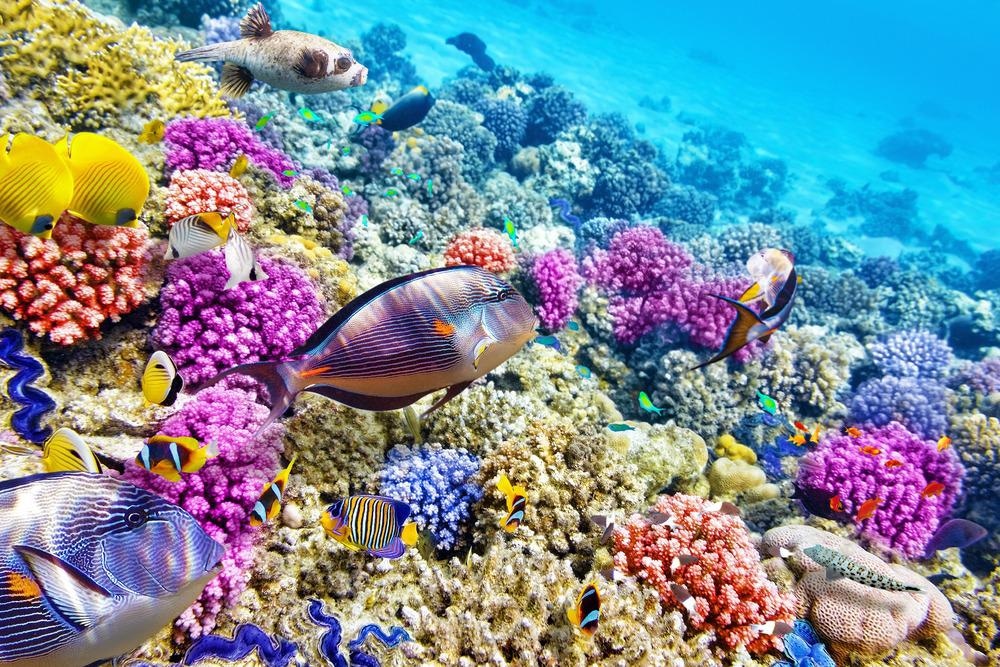Monitoring coral reefs’ degrading health is an essential task for environmental science, but it is still technically difficult. A team of computer scientists from the Woods Hole Oceanographic Institution, Massachusetts, was recently awarded a grant to develop image collection and acoustic analysis technologies for robots to automatically gather information about reef ecosystems.

Image Credit: V_E/Shutterstock.com
The grant, awarded by the National Science Foundation and shared with Syracuse University, is intended to help the organizations advance robots’ abilities to study coral reefs. They plan to do this by developing autonomous underwater vehicles that can find their way around complex underwater environments and gather data.
The Woods Hole team is led by computer scientist Yogesh Girdhar, and is trying to create a robot that can measure multiple properties of the reef over a long period of time. The robot needs to take readings on the reef’s biomass and biodiversity, as well as record information about the behavior of organisms living or traveling through the reef system.
Coral reefs play an important role in the well-being of our planet: they support a healthy ocean ecosystem by creating habitats for numerous and varied animal species. About a quarter of all marine organisms rely on a coral reef at some point in their lives, and reefs also protect human habitats from storms and erosion.
In 2020, a report on the status of global reefs worldwide by the Global Coral Reef Monitoring Network valued reefs’ benefits to human society at around $2.7 trillion each year. But despite the important role they play, reefs are declining all over the world. This is caused by global warming, ocean acidification, pollution, and damage from industrial fishing and shipping.
The scale and importance of the problem of reef health around the world has inspired many scientists, researchers, and agencies to actively seek solutions to protect it. The key to solving a problem like this is understanding reef health, but technology is still not available that can help us effectively monitor reefs’ changing circumstances.
Girdhar said:
“The tools we have right now to study coral reefs are pretty primitive. The robots and the sensors we have at the moment can’t capture the spatial and temporal diversity of a reef at the same time. We want to amplify the capability of scientists in the field and the tools they’re using.”
To overcome this Girdhar and his team are working with a $1.5 million grant entitled “An Ecologically Curious RObot for Monitoring Coral Reef Biodiversity.” The grant was made as part of the US National Science Foundation’s National Robotics Initiative 3.0 program, which is intended to support foundational research to integrate the next generation of robots with human attributes like safety and independence.
The team is working with a concept that includes two input systems: image collection and acoustic analysis. The robot will process this information in a way analogous to a “curious diver,” that is, by exploring caves and passages that seem likely to give up more interesting data further in.
The imaging system enables scientists to accurately identify individual species and any locations of interest in a geospatially complex environment. However, these have limited range underwater where not much light reaches. Acoustic signals, on the other hand, work well underwater and can provide a good overall picture of a reef’s health. However, they cannot provide enough information to identify individual species.
The Woods Hole team is combining the two input systems to get the best of both worlds in their robot investigator. This will enable the robot to build an accurate, detailed picture of the reef ecosystem, its health, and its functions in the same way that a trained scientist diving into the system manually would operate.
The team also needs to overcome the problem of the robot itself disturbing animals that live around the reef. The presence of a moving robot is enough to disrupt animals’ behavior and cause them to scatter to other parts of the reef or hide in gaps.
To address this, the robot has been designed with a “hopping” motion system that makes it move quickly in short distances, then settle down on the sea bed or reef itself to gather data. Moving in short bursts also enables the robot to use as little energy as possible and greatly extend its possible mission length. This gives it advantages over most other swimming robots used for environmental analysis and enables the robot to gather much more information over a longer period of time.
“We envision putting the robot in a reef, and having it come back in a week or month with a detailed understanding of how biodiversity is distributed across the reef in space and time,” Girdhar said.
It will really give coral reef scientists more bang for the buck over each deployment.”
The curious robot is one of many new bio-inspired robots being used for environmental monitoring applications. For example, the Envirobot built by Swiss Biorobotics Laboratory has a motion system inspired by eels, and detects water pollution in real-world conditions. Robot jellyfish have also been designed to passively float in the ocean and gather data to help us understand climate change.
References and Further Reading
Dwivedi, R. (2019). How Can Robots Help Fight Climate Change? AZO Robotics. [Online] Available at: https://www.azorobotics.com/Article.aspx?ArticleID=294.
Pilkington, B. (2022). Can Soft Robots Become Truly Sustainable? AZO Robotics. [Online] Available at: https://www.azorobotics.com/article.aspx?ArticleID=453.
Souter, D., S. Planes, J. Wicquart, et al (2020). Status of the Coral Reefs of the World. Global Coral Reef Monitoring Network. [Online] Available at: https://gcrmn.net/.
WHOI (2021). Development of a curious robot to study coral reef ecosystems awarded $1.5 million by the National Science Foundation. Woods Hole Oceanographic Institution. [Online] Available at: https://www.whoi.edu/press-room/news-release/development-of-a-curious-robot-to-study-coral-reef-ecosystems-awarded-1-5-million-by-the-national-science-foundation.
Disclaimer: The views expressed here are those of the author expressed in their private capacity and do not necessarily represent the views of AZoM.com Limited T/A AZoNetwork the owner and operator of this website. This disclaimer forms part of the Terms and conditions of use of this website.